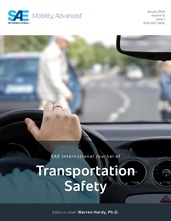Background. Road safety is a major public concern, as road traffic accidents
result in numerous casualties and significant economic losses. In traffic
collisions, the pattern of injuries sustained by drivers often varies depending
on various accident factors. The interactions between safety device use, alcohol
consumption status, and injury locations can reveal important association
patterns and insights. Therefore, we examine patterns in injury locations,
accounting for safety device use and alcohol consumption.
Method. In this study, we applied two complementary graphical approaches,
including multiple correspondence (MCA) analyses and mosaic plots (MPs).
Results. The MPs reveal the existence of meaningful patterns between injury
location, alcohol consumption, and safety device. Likewise, the MCA reveals that
head/neck injuries are more likely to be associated with alcohol impairment. In
particular, sober status and safety device used tend to be associated with all
injury locations, excepted head/neck injuries. Furthermore, the chi-square
statistic with p < 0.05 rejects the null hypothesis (
H
0
) of non-association between injury location, safety devices, and alcohol
consumption factors. By providing concrete evidence and insights, these findings
can inspire policymakers and safety device manufacturers to improve the
effectiveness of safety devices.
